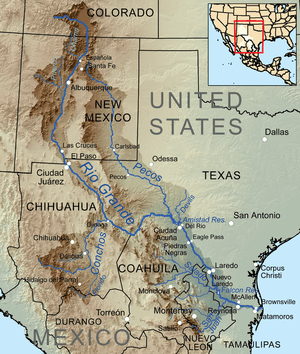Devils River (Texas)

The Devils River is a whitewater river in southwestern Texas, part of the Rio Grande drainage basin. It begins in northwest Sutton County, at 30°19′40″N 100°56′31″W / 30.32778°N 100.94194°W,[1] where six watercourses come together, Dry Devils River, Granger Draw, House Draw, Jackson, Flat Rock Draw, and Rough Canyon. It flows southwest for 94 miles (151 km) through Val Verde County and empties into the northeastern shore of the Amistad Reservoir,[2] an impoundment of the Rio Grande near Del Rio, Texas on the Texas/Mexico border, 29°27′33″N 101°3′34″W / 29.45917°N 101.05944°W.[1] The discharge of the Devils River, as measured at IBWC gaging station 08-4494.00 near the river's mouth, averages 362 cubic feet per second (10.3 m3/s), with a maximum of 122,895 cubic feet per second (3,480 m3/s) and a minimum of 54 cubic feet per second (1.53 m3/s). Its drainage basin above that point is 10,259 square kilometres (3,961 sq mi).[3]
The Devils River is considered the most unspoiled river in Texas.[4] Its remote location in a hostile environment limits pollution from human and animal populations. In addition, the river flows underground for part of its journey. As it passes underground, the gravel, sand and limestone scrub the river water clean before it re-emerges some 20 miles (32 km) downstream.
Recreation
Although the river is popular for kayaking and canoeing, it is difficult to gain access because much of the river is bounded by private property. However, much of the river is protected through conservation easements on both sides. The Nature Conservancy is working to protect the river through the Devils River Project. As of now July 2010, the project has protected 87,000 acres (350 km2) along the river. Along with the Devil's River State Natural Area the protected land along the river totals 110,000 acres (450 km2).
Traversing the river
The river itself is 90 miles (140 km) long, but much of the upper half of the river is not suitable for canoeing or kayaking because of a lack of water and limited access. The best part of the river for recreation is about 40 miles (64 km) long and runs from Bakers Crossing to the last drop off point at Lake Amistad. The most common point of entry into the river is Bakers Crossing on Texas State Highway 163. Camping sites are available and you can also leave your vehicle at Bakers Crossing. Most of the river is fairly calm with mostly class two rapids and small class three rapids (see International Scale of River Difficulty). However the river can rise and fall greatly with rainfall, even if the rain is not in the direct area of the river. Dolan Falls is a waterfall about 15 feet (4.6 m) tall and is located at about 16.9 miles (27.2 km) and must be avoided. Past Dolan Falls at about 19 miles (31 km) is Three Tier Rapids, a class four rapid most of the year, but when the river swells, can be a short class 5 and should be attempted by only by the more experienced paddlers. The river is characterized by long, deep pools with reed covered rapids near the end of these pools. A map is strongly suggested as both Dolan Falls and Three Tier Rapids are not able to be seen until you are right on top of them. After Three Tier Rapids, there are no more large (over class III) rapids and the river is fairly smooth. Some boulder and fields do occur past Three Tier Rapids but are generally small in size. The river finally empties into Lake Amistad after traveling some 40 miles (64 km) from Bakers Crossing. From this point it is another 12-mile (19 km) trip on the lake to the last take out at Rough Canyon Marina. The journey for the lake section of the trip can be very strenuous on a person kayaking or canoeing because of the strong south headwind.[5]

The experience
Part of the appeal of the river is its remote location, the very rugged and rough terrain, and lack of human presence. There are only five visible houses in the first 20 miles (32 km) of river. At about 25 miles (40 km) the Dry Devils River flows into the Devils, and is considered by many to be the halfway point. There are many homes in this point of the river and is called the Blue Sage Subdivision.
See also
- List of rivers of Texas
- List of tributaries of the Rio Grande
- Patrick Dearen, author of Devils River: Treacherous Twin to the Pecos, 1535-1900 (2011) ISBN 978-0-87565-423-2
References
- ↑ 1.0 1.1 U.S. Geological Survey Geographic Names Information System: Devils River
- ↑ Devil's River from the Handbook of Texas Online
- ↑ "Water Bulletin Number 75: Flow of the Rio Grande and Related Data; From Elephant Butte Dam, New Mexico to the Gulf of Mexico". International Boundary and Water Commission. 2005. Retrieved 17 July 2010.
- ↑ "Devils River Protection Campaign, Devils River Conservation Easements". The Nature Conservancy. Retrieved 22 July 2010.
- ↑ "Devils River, Texas". Southwest Paddlers. Retrieved 22 July 2010.
External links
Coordinates: 29°27′33″N 101°3′34″W / 29.45917°N 101.05944°W